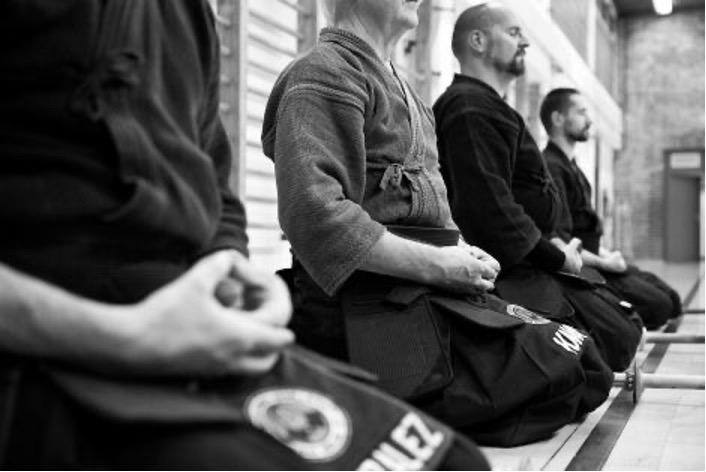
The Technology of Meditation
Mental recalibration for improved sport performance
Kendo sword fighters (above) clear their minds ahead of a practice session. This ritualized pre-session mental recalibration is called Iaido, “The way of mental presence and immediate reaction.” Iaido can be roughly translated as “being constantly prepared to respond to sudden attack spontaneously and appropriately.” Optimally, coming out of this pre-session mediation, these men seek to attain a state of internal quietude characterized by hyper-alertness. A sword can be moved at 150 miles an hour, far too fast for conscious thought to react. Thought impedes the requisite immediacy needed for a spontaneous (yet appropriate) response.
I have studied and practiced meditation since 1975. My original reason for delving into meditation, in all its forms and guises, was purely athletic. I felt certain that meditation would up my athletic performance – how could it not? I was not seeking enlightenment, nor was I interested in following gurus or joining a religion. I wanted to study the mechanics of meditation, the technology of meditation, I wanted to understand and amalgamize, adapt it for my own secular purposes. I meditated to up my athletic game.
I began daily practice. I began a meditational journey that continues to this day. I am a meditational researcher, always on the lookout for quality information from true meditational masters. Meditational goals and methods vary dramatically, and I sought books and literature that revealed the specific procedures and techniques unique to each meditational school. As I grew older and wiser and as my “practice” deepened, I began to cross-compare the various meditational modes and methods. I began building a mediation library that by 2021 has grown to over 150 books.
I delved into the nuts and bolts of meditation. How do the true masters of a particular school of meditational thought approach meditation? What is the overarching, sought-after mind-set? I combed Yes bookstore in Georgetown for books on Hindu, Zen, Taoism, Tibetan Buddhism, Sufism, et. al. Plus all the subsects. For example, Zen is divided between Soto and Rinzai, each with subtle and overt differences. The South Asian Buddhist meditational techniques were vastly different than meditational techniques taught by central China Taoists. The desired optimal mindset in Pondicherry-inspired Indian Hinduism was light-years different from the mindset goal of the Dogen Zenji Soto Zen school. I sponged up everything and began formal practice.
I had a mindset-alteration head start. By age 25 I already was a 10-year practitioner of Soviet autosuggestion, a performance-elevating eastern European mental technique. Autosuggestion instructs the athlete to run continual mind-movies of themselves performing flawlessly in the about-to-happen practice session. This repeated visualization technique was specifically designed to improve sport performance. Nowadays this technique is SOP and widely used, in 1965 this was revolutionary stuff. The Iron Curtain coaches determined that if they had an athlete, regardless the sport, repeatedly runs a mental movie of the about-to-happen drill or event, performance improved. The better the visualization, the greater the degree of improvement. Visualization improved with repetition.
As a highly imaginative 14-year-old, I began using the autosuggestion procedure. In between training sessions, I would daydream about upcoming training sessions. I would see myself dominating whatever poundage I was due to handle in a particular lift. In the actual training session, prior to a top set, I would shut my eyes and visualize. Immediately before a big effort, I would run one final mental movie. With each successive visualization, I sought to produce ever-greater clarity and vividness. When it was time to turn psychological visualization into physical reality, I was so psyched the line between reality and imagining blurred.
YouTube up 1980s superstar Soviet Olympic weightlifters like Piseranko, Vardanian, Zacheravich…watch how they stride to the barbell with a faraway look in their eyes. They stop, stand over the barbell for a full minute, eyes opened yet unfocused. They are lost in their final auto-visualization. Done, they stoop, set their hook grip, and turn mental movie into a world record reality. For them and me, a successful lift was déjà vu all over again.
In 1995, as a top-gun writer for Muscle & Fitness magazine, I interviewed the inventor of this Iron Curtain auto-suggestion technique, Dr. Aladar Kogler. Originally a Hungarian fencing coach, his Mind techniques were so revolutionary and successful that they were declared state secrets. Kogler used conscious thought and logic to mentally morph the athlete into the elevated state of attention.
Logic talk, positive talk, coupled with intense and repeated visualizations improved athletic performance. It was a very western approach that used logic and reason to think our way into altered states of consciousness beneficial for athletic performance. Kogler, the Soviets and East Germans were the male Yang of mind-alteration: use conscious thought and mind movies to improve athletic or artistic performance.

East and West: Yin & Yang
- Eastern philosophic approach: Yin, intuitive, artistic, spontaneous, improvisational, creative. Clear the Mind. Use meditation to elongate the “gap between thoughts,” where “reality” lies hidden in plain sight. Instead of harnessing the Mind, quit the Mind. Find a way to cause the internal voice, the thinker, the observer, to fall silent. Quietude is the optimal athletic mindset for improving athletic performance.
- Western philosophic approach: Yang, logic, mathematical, mechanical, disciplined, tenacious. Couple intense visual fantasies with power wording designed to focus and concentrate the athlete on the task at hand. Use conscious thought to think our way into an elevated, concentrated mental state conducive to improved sport performance. The mind is used, not asked to fall silent.
The eastern religious meditational traditions are the Yin to the West’s Yang: eastern meditational techniques sought, not to harness and direct the conscious Mind, rather to quiet the conscious Mind. Instead of repeated mental movies, eastern meditational techniques would show a blank screen. The eastern traditions assert that “reality” can only be perceived in the gap between thoughts. Clear the Mind and the quietude births a hyper-alertness.
This degree of sensitivity only appears when the internal commentator, our mental chatterbox, the voice in our head that always comments, finally falls silent. The samurai warrior in a one-on-one sword fight seeks a blank yet electrified mindset, an amplified hyper-alertness, a state-of-being so sensitive that an opponent’s slightest twitch is countered in a micro-second.
Adam Smith’s book, Powers of the Mind, pointed out a dramatic mindset goal differentiation between southern India Hindu meditational techniques and the mindset sought by Zen adherents. In studies done at the Menniger Institute in the 1970s, scientists and doctors hooked up Zen Monks and Hindu Gurus to electronic monitoring devices. The scientists would allow these meditational masters to dive deep into their meditational state, then sneak up behind them and fire off a pistol.
The Hindu meditational masters were so deep within their trance-state that they did not hear the gun, it did not register or pierce the depth of their deep internal altered state. The Zen masters heard the gun in its fullness – but did not react – no disturbance to their hyper-alert equilibrium. The 150-decibel gunshot was noted, but did not disturb their profound equilibrium, their centered silence.
Hindu adepts enter trance states so deep they can lie on a bed of nails, slow their breathing to near-death, be buried for days or have their bodies pierced without reaction. One Swami stunned the Menniger Institute scientists when after they had hooked him up, he told them he would now stop his heartbeat. Which he did for ten seconds. The Zen mindset became synonymous with the samurai warriors who found the Zen blank-yet-alert mindset ideal for life-or-death warfare. There are shades and flavors of meditation, largely geographic distinctions. A meditational synthesis would have many unifying characteristics...
- Posture: sit on a cushion that elevates the tailbone. Cross the legs. Sit upright. Do not slump. Slumping is indicative of a loss of focus. A straight spine enables full and easy diaphragm breathing. The head is upright. Perfect skeletal posture provides the structure for successful meditation. No slumping!
- Eye focus: three schools of thought; eyes wide open and focused on an external object; eyes closed to eliminate visual stimulation of any kind; eyes half opened and semi-focused. Pick one of the three for a formal session; don’t wander between them.
- Breathing: deep diaphragm breathing is sought after. Push the floor of the abdominal downward, creating a vacuum that maximally fills lungs. Great concentration is built by following the inhalation and exhalation. Pay attention to the sound of the exhalations. Adepts make no nostril noise when exhaling.
- Hand position: the “cosmic mudra,” is a hand position. While in full or half-lotus or sitting in a chair, place the left hand, palm up, next to your belly. Lie the right hand atop the left. Allow the thumbs to lightly touch. Don’t crunch thumbs or allow them to separate: this is your attention meter.
- Counting breathes: Zen beginner practice has the meditator count breathes from 1 to 10. The goal is to not let thoughts arise, capture your attention, and cause you to lose count. Lose count and go back to zero and begin anew. Let thoughts arise and float away. Practice, repetition, improves focus and concentration.
- Beyond counting: at some point, the Zen meditator “throws away the toys,” they stop counting. The mediator becomes conscious of mechanics of breath without counting. Similarly, mantras are also abandoned. When thoughts arise, they are noted and allowed to pass without comment or commentary.
- Expand the gap between thoughts: over time, with repetition, meditational practice deepens. The meditator cultivates mental silence. They seek to lengthen the gap between thoughts. “Reality” is only detectable when conscious thought falls silent. Willpower enforced silence is no silence at all.
- Dropping off of Mind and Body: deep meditation has a revitalizing effect; you do not have to be a Zen master or Hindu guru to experience the brain-cleansing, energy-infusing, stress-relieving benefits associated with deep meditation. When “the Mind of no Mind” is attained, we are stress-free.
- Moving meditation: t’ai chi, pa kua and hsing I, the Chinese internal martial arts, were designed to attain a meditational mindset, then put the body and the meditational mindset into motion. Movement and meditation are intertwined.
- Exercise-induced Nirvana: intense physical exercise, especially high-intensity resistance training, causes the conscious mind to fall silent. Intense training releases hormones, creating a post-workout “glow state,” that is, factually, an advanced (if unrecognized) meditational state.
About the Author
As an athlete Marty Gallagher is a national and world champion in Olympic lifting and powerlifting. He was a world champion team coach in 1991 and coached Black's Gym to five national team titles. He's also coached some of the strongest men on the planet including Kirk Karwoski when he completed his world record 1,003 lb. squat. Today he teaches the US Secret Service and Tier 1 Spec Ops on how to maximize their strength in minimal time. As a writer since 1978 he’s written for Powerlifting USA, Milo, Flex Magazine, Muscle & Fitness, Prime Fitness, Washington Post, Dragon Door and now IRON COMPANY. He’s also the author of multiple books including Purposeful Primitive, Strong Medicine, Ed Coan’s book “Coan, The Man, the Myth, the Method" and numerous others. Read the Marty Gallagher biography here.



